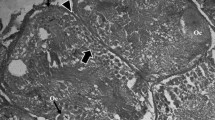Summary
In order to study the rapid incorporation of amino acids into the vitelline glands and the ovary of liver flukes they were incubated for 10 minutes in dl-tyrosine-3-14C, l-methionine-35S, and glycine-2-14C, respectively. The process was followed by histological radioautography and by paper electrophoresis and paper chromatography in combination with radioautography. All amino acids used were rapidly incorporated into the fluke. A difference existed with regard to the incorporation into the mentioned organs. Thus, with labelled tyrosine, methionine, and glycine in the incubation medium radioactivity was observed in the ovary but only tyrosine gave rise to radioactivity in the vitelline glands. The paper electrophoretic and paper chromatographic studies with material from tyrosine-3-14C treated flukes revealed that this amino acid could occur free or peptide linked in the ovary as well as in the vitelline glands. The results with methionine-35S showed that 35S in the ovary was due to free methionine-35S and less probably to 35S bound to protein. Similar studies on material from glycine-2-14C treated flukes showed that this amino acid was metabolized and thus could occur as glycine and/or metabolites in the ovary. The results do not indicate that the mentioned amino acid or any of its metabolites were incorporated into protein in the ovary.
Zusammenfassung
Um den schnellen Einbau von Aminosäuren in die Dotterstöcke und das Ovar des großen Leberegels zu studieren, wurden diese 10 min in Anwesenheit von dl-Tyrosin-3-C14, l-Methionin-S35 und Glycin-2-C14 (Glykokoll) in vitro bebrütet. Danach folgte die histologische Autoradiographie und papierelektrophoretische sowie papierchromatographische Untersuchung in Kombination mit der Autoradiographie. Alle verwendeten Aminosäuren wurden vom Leberegel schnell eingebaut. Es bestanden jedoch Unterschiede hinsichtlich der verschiedenen Organe. Mit markiertem Tyrosin, Methionin und Glycin wurde Radioaktivität in den Ovarien festgestellt, mit Tyrosin jedoch nur in den Dotterstöcken. Die papierelektrophoretischen und papierchromatischen Studien an Tyrosin behandelten Egeln ergab, daß diese Aminosäure frei oder an Peptide gebunden im Ovar ebenso wie im Dotterstock zu finden war. Methionin-S35 lag im Ovar als freies Methionin und weniger wahrscheinlich an Protein gebunden vor. Ähnliche Studien mit Glycin-2-C14 behandelten Egeln ergaben, daß diese Aminosäure abgebaut wird und als Glycin und/oder als Stoffwechselprodukt im Ovar auftritt. Die Resultate gaben keinen Anhaltspunkt dafür, daß die erwähnte Aminosäure oder irgendeines ihrer Abbauprodukte in das Protein des Ovars eingebaut wird.
Similar content being viewed by others
References
Björkman, N., and W. Thorsell: On the fine morphology of the formation of egg-shell globules in the vitelline glands of the liver fluke (Fasciola hepatica, L). Exp. Cell Res. 32, 153–156 (1963).
— On the ultrastructure of the ovary of the liver fluke (Fasciola hepatica, L). Z. Zellforsch. 63, 538–549 (1964).
Dawes, B.: Maintenance in vitro of Fasciola hepatica, L. Nature (Lond.) 174, 654–655 (1954).
Dent, C. E.: A study of the behaviour of some sixty amino acids and other ninhydrin-reacting substances on phenol-“collidine” filter-paper chromatograms, with notes as to the occurrence of some of them in biological fluids. Biochem. J. 43, 169–180 (1948).
Govaert, J.: Etude cytologique et cytochimique des cellules de la lignée germinative chez Fasciola hepatica. Exp. Parasit. 9, 141–158 (1960).
Gresson, R. A. R.: Electron microscopy of the ovary of Fasciola hepatica. Quart. J. micr. Sci. 105, 213–218 (1964).
Hais, I. M., u. M. Macek: Handbuch der Papierchromatographie, Bd. 1, S. 412–510. Jena: Gustav Fischer 1958.
Krvavica, S., Ž. Maloseja, H. Wagner, and T. Martinčić: The amino acid composition of the proteins and the distribution of fatty acids in the lipids of eggs of Fasciola hepatica and Ascaris suum. Vet. Arch. (Zagreb) 34, 163–166 (1964).
L.K.B. Paper electrophoresis equipment. Stockholm 1959.
National Academy of Sciences. National Research Council Publ. 719, Specifications and criteria for biochemical compounds. Washington 1960, 1963.
Pantelouris, E. M.: Sulfur uptake by Fasciola hepatica L. Life Sci. 3, 1–5 (1964).
Smyth, J. D., and J. A. Clegg: Egg-shell formation in trematodes and cestodes. Exp. Parasit. 8, 286–323 (1959).
Thorsell, W., and N. Björkman: Morphological and biochemical studies on the absorption and secretion in the alimentary tract of Fasciola hepatica, L. J. Parasit. 51, 217–223 (1965).
—, and B. K. Nordberg: 14CO2-fixation by Bacillus anthracis. Acta chem. scand. 17, 1330–1334 (1963).
Author information
Authors and Affiliations
Rights and permissions
About this article
Cite this article
Thorsell, W., Björkman, N. & Appelgren, L.E. Radioautographic studies on the ovary and vitelline glands of the liver fluke, Fasciola hepatica L. after short in vitro incubation with some amino acids. Z. F. Parasitenkunde 28, 108–115 (1966). https://doi.org/10.1007/BF00260237
Received:
Issue Date:
DOI: https://doi.org/10.1007/BF00260237




